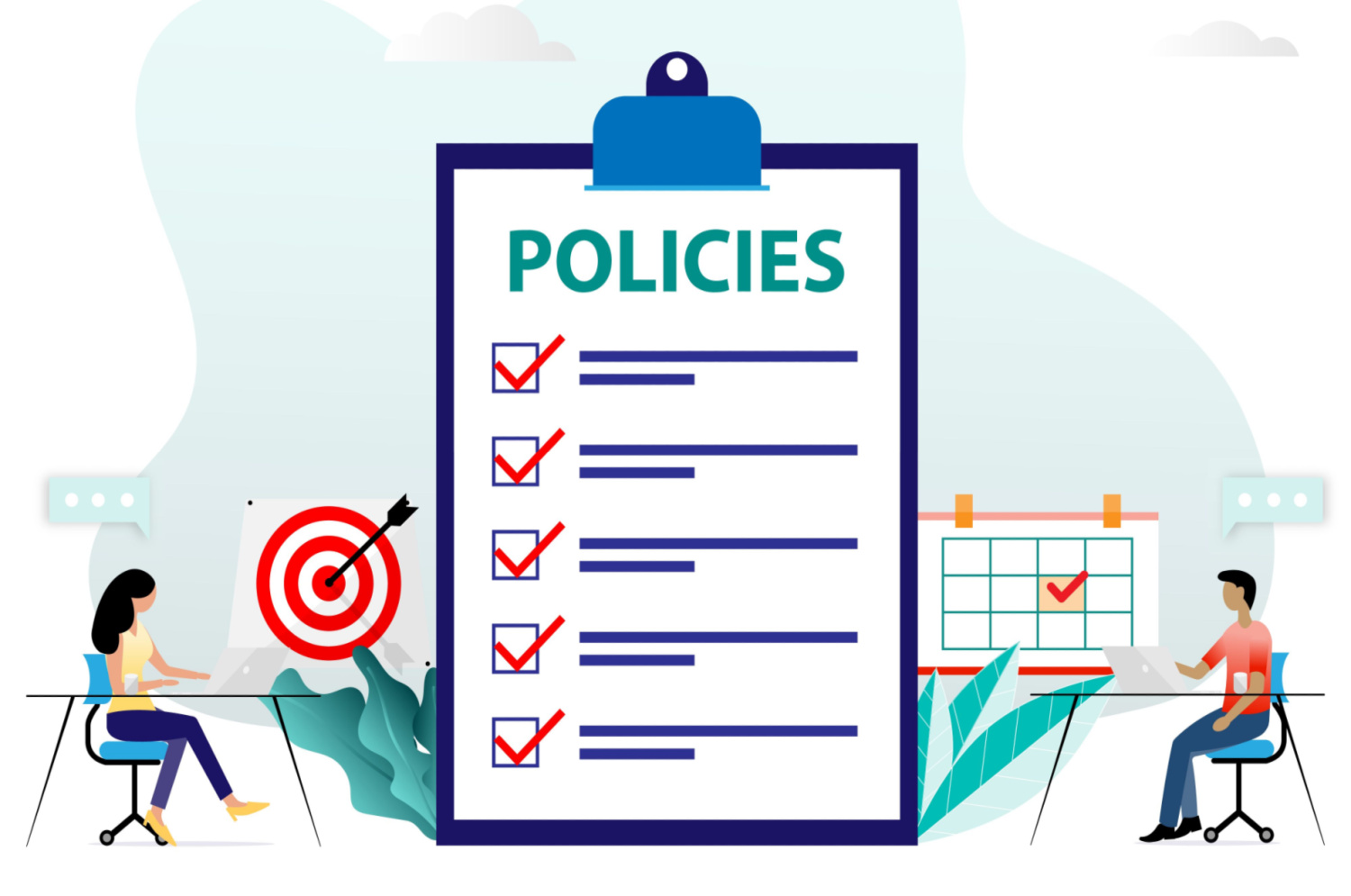How to Write & Manage Company Policies & Procedures
Regardless of size or industry, policies and procedures lay the foundation of how your organizational structure and employees will operate.


Let’s say you own an ice cream shop with 15 employees. Five of them were trained and are currently managed by someone who was trained by you. Another five were trained by someone else with a different background and maybe less customer service experience than you. Even though you run a relatively lean operation, you have various employees operating in completely different ways, making it difficult for you to provide a consistent experience for both your customers as well as your employees.
No matter the size of your company or which industry you operate in, policies and procedures lay the foundation for how your organizational structure and employees will operate. Despite this, it can be very difficult to create — let alone manage, enforce, and update — workplace policies and procedures. Whether you do this manually or have a system for it, understanding the processes and best practices is important for creating new ones or finding ways to optimize your current methods.
What are workplace policies & procedures?
First, we need to define policies and procedures because they are not interchangeable.
Policies are high-level and general guidelines that act as an outline for how an organization deals with a particular issue. They also point those at the company in the same direction towards a goal, vision, or value and ensure everyone is on the same page.
Procedures are the specific steps that will be taken to carry out a policy. Like a roadmap or flowchart, procedures inform employees what to do and when in particular situations.
Policies and procedures work together as the “what” and “how” in response to common workplace problems or risks. They inform those at the company not only what everyone should be aspiring towards, but also specifically what’s expected of them and how to accomplish it.
Why are they important?
The key to what makes policies and procedures important to any workplace is efficiency. They make it clear what is and is not acceptable, convey the values and expectations of the organization, and minimize HR issues. All of these lead to a more aligned company culture and higher-quality work output. Policies and procedures also keep regulatory compliance and employee accountability organized and clear so you can refer back to them whenever necessary and without wasting unnecessary time.
Types of policies & procedures
There is a wide variety of issues or concerns that can arise in a workplace, so there are also a variety of policy types with corresponding procedures to address them. We discuss some of the major ones below:
Attendance
One of the most basic policies you need to have is for attendance. If employees are not showing up to work, no other policies or procedures really matter. In addition, absenteeism is a sign of disengagement and costs the organization for the time missed, replacing the employee, and disruptions to the processes and projects they are a part of. Attendance policies and procedures should cover things like tardiness and sick days, but also vacation time, appointments, and volunteer hours.
Conduct
While conduct encompasses a lot (harassment, discrimination, smoking, etc.), it is also a critical piece of your policy base and could be the most important in terms of employee retention. This sets the basis for how employees behave at work, from drug and alcohol use to bullying and workplace harassment. Taking a hard stance against unprofessional and harmful behaviors will make employees feel more comfortable and more likely to stay with your organization.
Equal opportunity
Besides being illegal, unfair favoritism in the workplace makes employees feel like they are not being given the opportunities and time they deserve. This creates resentment between coworkers and can lead you to lose or overlook your best employees because they are not favored by a manager. Create a fair work environment with policies that prevent inequity based on race, gender, age, religion, disability, or other characteristics.
Health & safety
If your employees do not feel safe while at work, they will probably either leave or cost you tens of thousands (or more) in lawsuits and settlements. In fact, OSHA awarded workers over $30 million in 2020, which is what happens when an organization does not have effective health and safety procedures in place. Cover things like illness or injury while working, equipment safety guidelines, fire and natural disaster procedures, and how to report an issue.
Use of company property
How employees use company property and money can have a serious detriment on your business if not guided and explicitly told what is off-limits. While workers have to use company property to do their jobs, you need policies and procedures for what people are and are not allowed to do with physical property as well as company money.
Remote work
Since the start of the COVID-19 pandemic, remote work has become much more common and looks like it will at least be an option for the foreseeable future. While higher efficiency can be a benefit of remote work for many businesses, it can also lead to more social media use and distractions.
This is why it is now paramount for all businesses to have remote work policies for who can work remotely, how often, what equipment they will use, and more. It is also important to consider how working remotely will impact your other policies and procedures such as health and safety, attendance, and conduct.
Writing policies & procedures for your workplace
Now that we know what basic policies and procedures an organization needs, how do we go about creating them? There are many things that need to be taken into account for any policy you’re planning, as well as characteristics of successful procedures, so let’s break it down.
Considerations
For foundational considerations when planning out a policy, the first thing you should do is consider its concrete purpose or goal. Is it meant to decrease injuries in the workplace? Reduce tardiness or damages to company equipment like laptops? This will inform all of your other choices and set the end goal that you want to reach.
Next, think about who this policy and its procedures will affect. Is it limited to lower-level employees to not only follow the guidelines but also police them? Is management tasked with enforcing them? If you are creating policies that pertain to time away from work (attendance, smoke breaks, remote work, etc.), will it impact customers?
The final major consideration is to clearly define the line between acceptable and unacceptable. We’ll discuss this more in the next section, but having clear, concrete, and precise guidelines will avoid any ambiguity. In addition to this cutoff, you should also consider and decide on consequences for not adhering to the policies and procedures. Take care to ensure they match the severity of the issue and think about whether multiple levels of consequences for different violations are necessary.
What makes a good policy or procedure
The biggest issue policies and their procedures have is ambiguity. You need to make sure that your employees understand exactly what the expectations and boundaries are with no interpretation. If issues have a clear, binary answer (yes it broke the rules or no it did not), it will remove any doubt about unfair punishment or whether someone deserves consequences.
However, just because policies should be firm and concrete doesn’t mean they should not change. One of the keys to a successful policy is its longevity, which is enabled by adaptability and periodic evaluations and updates. In addition, they should be realistic and supported by leadership, which will help other employees get on board and abide by them as well.
Enforcing & managing workplace policies & procedures
Part of a policy’s longevity also comes from how it is enforced and managed. If it is not followed or used, it will fall by the wayside and eventually disappear. If it is not managed through feedback and updating to meet the changing requirements and environment of the organization, it will also become irrelevant and also disappear.
This is why having technical or administrative controls to track and oversee your policies and procedures is crucial to doing this effectively. A company could have dozens of policies with hundred of procedures, so having everything centralized and easily accessible for everyone can make or break their success. By creating a central hub of policy and procedure information, you can keep track of what needs updating, what is accessed the most, and organize everything in a way that makes sense for your organization.
Start building your Governance Center today
Igloo’s Governance Center is exactly that: An internal and easy-to-access hub of policies, procedures, and processes so you can manage and enforce them, but also stay compliant with your industry’s regulations and guidelines. It helps simplify and streamline your policy creation, management, organization, and regulatory compliance processes so everyone is on the same page. Get started with your company’s Governance Center today.







